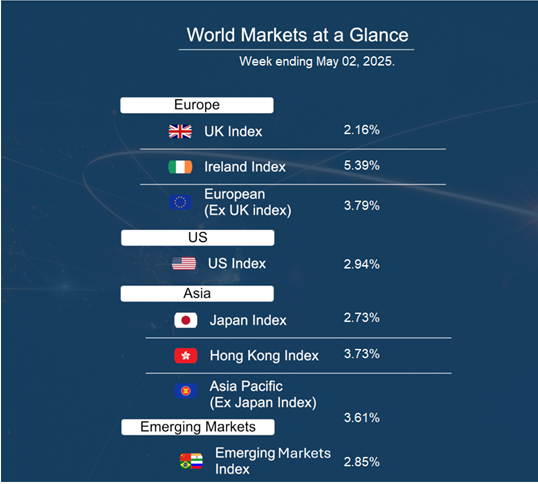US labour market data presented mixed signals but ended the week on a positive note. Job openings declined in March, and private payroll growth slowed sharply in April. However, the more closely watched nonfarm payrolls report exceeded expectations, with employers adding 177,000 jobs—well above forecasts. Wage growth remained modest, and the unemployment rate held steady at 4.2% in April 2025, suggesting that while hiring has cooled, the broader labour market remains strong. The surprise strength in Friday’s report lifted investor confidence and helped push stock prices higher to close the week.
In other news, data revealed that the U.S. economy contracted by 0.3% in the first quarter of 2025—its first contraction in three years—primarily due to rising imports, a moderation in consumer spending, and reduced government outlays. However, the composition of the data showed some resilience. A 41.3% surge in imports, driven by businesses and consumers rushing to make purchases ahead of expected tariff hikes, pointed to a front-loading effect rather than a structural weakness. Therefore, this contraction wasn’t due to fading demand but rather trade-related distortions.
Meanwhile, the Fed’s preferred inflation measure, the Core Personal Consumption Index, remained flat in March, while consumer spending rose a healthy 0.7%, suggesting inflation is easing without significantly dampening demand.
European markets saw gains, with the Eurozone’s Q1 GDP surpassing expectations, growing by 1.2%. Investor sentiment was further lifted by news from China indicating a willingness to engage in trade talks with the U.S. While China’s mainland markets experienced slight declines during a shortened trading week, the prospect of trade negotiations and potential tariff exemptions offered hope that tensions could ease. Although official economic data fell short of forecasts, analysts noted that China has the fiscal flexibility to support growth if necessary.
Looking ahead, this week will see a shorter trading schedule in the UK and Europe due to the first May bank holiday, while global markets, including the US, will remain open. Notably, both the Federal Reserve and the Bank of England are set to announce key interest rate decisions.
The Fed is expected to hold rates steady on Wednesday, May 7th, while the Bank of England is widely anticipated to cut interest rates by 25 basis points the following day, Thursday, May 8th. In terms of data, we can expect the US Services PMI, China’s trade data, and Eurozone retail sales figures.
Kate Mimnagh, Portfolio Economist



